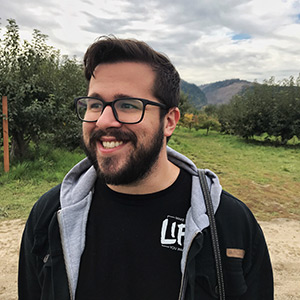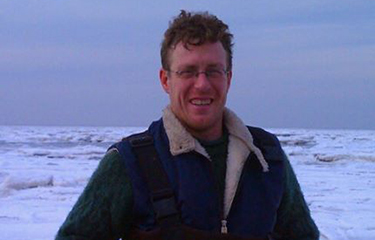Earlier this year, oyster farmer Edward “Ned” Gaine was chosen as New Jersey’s 2020 Outstanding Young Farmer by the New Jersey State Board of Agriculture.
Originally from Brooklyn, New York, Gaine earned degrees in marine biology and marine resource management from Stockton University, and after he began growing oysters in Cape May, he earned a master’s degree in biology from Rutgers University. With his love for aquaculture fully realized, Gaine then became the first person to acquire a fully-permitted aquaculture lease in the state of New Jersey, after the state opened an aquaculture development zone to allow shellfish farming in 2012.
Gaine has been presented with U.S. congressional recognition for his collaborative efforts. He has also been involved in habitat restoration on his leases, including placing over 10,000 bushels of shells to build the foundation of a new oyster reef.
SeafoodSource connected with Gaine to learn more about how he started farming oysters, his advice for industry newcomers, and how he explains his job to curious people.
SeafoodSource: How did you get started in oyster farming?
Gaine: I got into it sort of serendipitously and I also got a little bit lucky – it wasn't a direct path for me at all. I graduated college with a couple of degrees in the marine sciences in 2001. Before 9/11, I had a job lined up when I went home to New York City, but that summer, there was a hiring freeze because of 9/11. When I got home, I basically had to work the job I had when I was in high school, you know, like pushing carts in a supermarket, trying to find out what to do with my life. That didn't really work out for too long. I couldn't really stomach that – it was really depressing.
So I sort of took off, left the city, and started shooting out resumes everywhere. And then I got a hit for an aquaculture job as an assistant researcher down in Cape May, New Jersey. I jumped at it. At that point, I was working on the academic side – the state wasn’t really open to commercial aquaculture at that time. They were open to traditional clam and oyster aquaculture, but weren’t really open to structure-based, rack and bag, cage culture-type things.
As I was working there, I was paying attention, thinking this might be something I want to do. Aquaculture was just starting to come around and the U.S. was undergoing this giant market collapse across the country. Every neighbor I had was laid off, gas was USD 4.00 [EUR 3.64] a gallon and it was again, just this miserable time and I was left asking myself, "What am I doing here?" I’m working this cushy job that’s just providing assistance to people, while aquaculture is hitting a point where it’s about to open up and I’m watching all this news about the economy and how money works ... I decided that once the dust settled, I wanted to be on the production side of things. The master of my own destiny, you know?
That’s when I jumped ship and got into the first aquaculture development zone to allow shellfish farming in 2012.
SeafoodSource: How is that working out for you?
Gaine: I live my life around this weird cycle, but I get to go to work every day and I'm in the sun. I’m wearing boots, but my toes are effectively in the sand. I mean, it rains and it's windy and it's cold – those are the tough days. But the nice days, it's beautiful. That’s how I get to live my life.
And then I make food. I feed people. How cool is this? There is no other food, besides drinks, that people clink when they eat it. It’s a celebration when you eat oysters. I’m super proud of that. Oysters are not this comfort food you eat when you’re depressed. Oysters are a celebratory food for when you’re happy and excited.
SeafoodSource: How do you describe the work you do to others?
Gaine: I always say I’m a farmer, first and foremost. And the inevitable next question is, "What do you farm?" I say oysters and that’s when people’s heads explode. It’s an odd job to most folks. People don’t know the work that goes into bringing oysters to the table.
SeafoodSource: How do you explain the industry to people?
Gaine: If I’m explaining what I do to any other kind of farmer, I can explain the process and very quickly they understand it all at once. We’re doing the same thing. We’re buying seeds, planting seeds, taking care of our crops. We even grow oysters in rows. We have to deal with the same regulations and red tape.
[With] other folks, the response I usually get is, "Oh, you mean you fish for oysters?" And I have to tell them, no, I own my product. I don’t go out there and catch a wild product. In some cases, much like people who have hatcheries from my industry, they own it from the moment it sort of becomes alive. I've purchased it at a very small size, and then I have to take care of it. So in a lot of aspects, I'm putting money right up front, and I'm not trying to go find them. I'm getting them right up front. And then my goal is to keep them alive, as best as I can, so that I can sell them to my customer and hopefully they come out as a really high-quality product.
SeafoodSource: Have you found explaining aquaculture to people getting any easier over time?
Gaine: Americans are definitely starting to catch on more. The issue I think we face as a country is not only the aquaculture component, but what we eat and what we’re accustomed to eating. And I think that's the challenge with aquaculture in America – we’re not particularly culturing the top species. Aquaculture is like agriculture, but you know? We farm cows, chicken, and pigs – that’s what America eats. The low oyster is not really seen as a part of the American diet anymore.
But times are changing. People’s diets are changing and people are starting to think more about where their food comes from. And as America makes that shift, aquaculture has a huge potential to grow, to keep growing. But I think we need to change our diet and get more Americans talking about seafood.
I was at an event recently where clams and oysters were served on ice and there were folks asking, "What’s the difference between these oysters?' There’s a learning curve here when it comes to seafood.
SeafoodSource: You are on the leasing committee for the New Jersey Shellfisheries Councils and serve on the Atlantic County Board of Agriculture executive committee – why is industry advocacy important to you?
Gaine: It’s all about education, on a lot of levels. I want to make sure that the public is educated as to what we're doing in some regards. I am a farmer – all the stuff that I grow is mine – but I’m working in a space that’s not mine. I don’t own the water. It's very important for me to make sure I always have the public trust. I'm using their resource, their water to grow my product, so I want to make sure they know that I'm doing it, that I'm respectful of the environment, public health, public safety, etcetera.
You also have to be involved to fight for the industry when new policies are being drafted that could affect our work. A lot of things, unintentionally, can impact aquaculture, so it’s important to be involved and be apart of those conversations when issues arise.
SeafoodSource: What are the biggest changes you’ve seen in the industry? Or what are things you see changing in the near future?
Gaine: The industry as a whole is expanding. There are a lot of people looking to get involved with oyster farming and aquaculture in general. It's running a business – you have to comply with regulations, you have to comply with permits and licenses. In the state of New Jersey, it takes 13 different agencies regulate regulate my industry, which is a lot. So there’s some pressure right now to reduce that, streamline it to make things a little bit easier on people.
I don't necessarily disagree with that, but at the same time, every one of those agencies is responsible for something specific, typically protecting one component of the public. I don't mind making it easier as long as we're still protecting the public.
I like companies that approach business with the idea, "Do no harm." Aquaculturists are always pushing how green and sustainable we are, so to have any effects towards the contrary to that would be really problematic in my mind.
SeafoodSource: Do you have any advice for someone looking to get into the industry?
Gaine: Do your homework. Find out what the regulations are in your state, find out how your state is approaching aquaculture. There are a lot of farms out there right now – do the cost-benefit analysis on whether or not there’s room for you in the market. Who are you going to be selling to?
I have a graduate degree in biology. I got into business going oysters thinking, "Well, I know a lot about oysters!" But I hit a sharp learning curve – I was not educated on the business side of things. You might have this passion for being outside and wanting to grow things and wanting to be in the water, but you’ve got to learn how to run a business.
I'd say it was easier for me because there was an open field. Now there's a lot more competition. It's not going to be easy. The first year or two doesn't come with dramatic rewards. And it's certainly not a get-rich-quick scheme. You've got to put the legwork in and you're going to have to do some tough work ,but just struggle through it. It's a great life.
Photo courtesy of Ned Gaine







